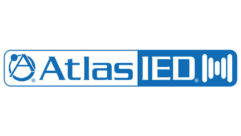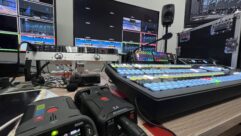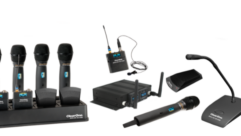
A Church Audio System for Traditional and Contemporary Services, Part 2
Dec 16, 2010 4:52 PM,
With Bennett Liles
Listen to the Podcasts
|
Editor’s note: For your convenience, this transcription of the podcast includes timestamps. If you are listening to the podcast and reading its accompanying transcription, you can use the timestamps to jump to any part of the audio podcast by simply dragging the slider on the podcast to the time indicated in the transcription.
Related Links

A Church Audio System for Traditional and Contemporary Services, Part 1
At Arapaho Road Baptist Church in Garland, Texas, they hold a traditional service and a contemporary service, but their technical requirements force them to be held in different rooms. …
Holding a traditional and contemporary service back to back with vastly different sound requirements proved to be a challenge for Arapaho Road Baptist Church in Garland, Texas. Dispersion Design was called in to devise a quick tech transition between the two and Luke Raymond is here to wrap up his talk on how it was done.
SVC: All right, Luke—Luke Raymond with Dispersion Design—thanks for being back with me for part two on the Arapaho Road Baptist Church installation with Aviom and several other things. You’re in Carrollton, Texas.
That’s correct and thanks again for having me. [Timestamp: 1:00]
I understand now with the Aviom system on stage there, which really speeds things up in the transition between the regular service and the contemporary service and getting all your technical ducks in a row between the two. You also put in some Ace backstage floor pockets. How did that go?
So I’ve always been very impressed with Ace backstage and impressed with the quality of their product as well as the custom engraved panels that they’re able to provide. The pockets are able to provide such a variety of different inputs that it’s very nice to be able to provide a customized stage set up for whatever the church that we’re installing for is, and we can put the Aviom outputs directly into the pockets around stage and then that reduces the clutter considerably. [Timestamp: 1:49]
Yes, so well, you’ve got some twisted pair running around a little bit.
That’s correct. We decided to re-install or replace all of the audio wiring in the entire main auditorium, and there was existing wiring there as well as existing wiring to the stage, but it was 20 years old or over 20 years old, and it’s always difficult to know until you get into the crevices where these wires are going to go and what sort of condition they’re in. We replaced everything. We replaced all the audio lines, ran new Cat-5 lines as they were no Cat-5 lines existing, and that gave us complete control over where the wires were going and what quality the wires were that were being put in place. [Timestamp: 2:38]
Right, and I guess then from that point on at least everybody knew where they went whereas before that, you rarely [could] find any specific documentation on where all this stuff goes and how the wiring is done.
That is correct. We at Dispersion like to make sure that everything is very well labeled and everything is well documented, and we provide our customers with our final documentation that explains how to find everything and how everything is labeled, but that’s probably the exception. What we are finding is that a lot of installers are not doing that and so when we come in it can be quite difficult to figure out what is currently there and where it does go. [Timestamp: 3:13]
And I noticed—I think I saw this listed somewhere—you have the Aviom A16 DA net distributors. How do they fit into all this?
We have a Yamaha LS9 digital console with the Aviom card installed in it. From there, we run back to an amp room back in the back where we have two of the A16 distributors. That allows us to distribute the A-net signal to multiple outputs in multiple pockets across the stage, each of which are powered since the A-net distributors provide power to the Aviom units that are plugged into them. So the advantage of that is that there is very little, if any, daisy chain of the Aviom mixers across stage. The musicians don’t have to worry about whether or not their unit needs to have power connected to it because the A-net distributors provide the power and provides a very clean and easy set up. [Timestamp: 4:16]
And you use, as you pointed out in part one, the LS9. I believe it’s the LS9-32 Yamaha mixer?
That’s correct. Yes. [Timestamp: 4:24]
And how do the volunteers do on that? How is that for retraining people?
So we had expressed some hesitation about going with the digital console at first. The reason being is that we do find that digital is still more of a learning curve for the volunteers who have not used a lot of audio equipment before, and it can be a bit more of a technical challenge. But along with the digital console comes the advantages of being able to reconfigure very quickly, is having a large number of prefacing channels that often would cost a lot of money externally if you used an analog system, and [it] provides more inputs for the money that you would not get with an analog console and a very small footprint. So we expressed to the church, up front, some of the concerns with going with the digital console, including the fact that the price difference is still quite high going from analog to digital and impressed upon them the fact that we were going to need to spend quite a lot of time training their volunteers. So what we did is the digital console was one of the first things to be installed. Before we had even run new wiring, we connected the console up to their existing system with their existing wiring and started the volunteers running the digital console for their services from the get-go every week while we did the install. So what that meant is that they had quite a number of weeks, I believe it was about five weeks, from the beginning to the completion of the install, running the digital console before the contemporary service even moved in. [Timestamp: 6:07]
Well that was a real good idea.
Yeah, that way they had quite a lot of experience with it, and it was really necessary and because really it took that long for them to get a handle on it. We provided an operator there with them every Sunday during those weeks to make sure that they had somebody there to ask questions and to give them advice and to be there if they got themselves into trouble. And they certainly, in the first few weeks, needed somebody to be there with them, but then we found as time progressed, they were able to navigate around more easily and they were able to run things on their own. [Timestamp: 6:45]
I know that getting away from the floor wedge monitors, to some extent, reduced the clutter on stage and helped with the acoustics. What kind of a system do they have out there for the FOH sound and the main speakers?
So the main speaker cluster is a mono speaker cluster. The room is octagonal and the seating wraps around 270 degrees. When we looked at the system and looked at the budget that was available, we realized that Arapaho was only going to be able to either fix the acoustics in their room or replace their speaker system and unfortunately both needed help. We realized that if they were to replace their main speaker system. they would not be able to get a sound that they were going to be happy with because of the fact that their room sounded so bad to start with. And so our recommendation to them was they fix the sound of the room and keep their existing sound system, and what we did is we replaced all of their amplifiers, all of their DSP, and we kept the flown speakers and utilized one of their existing subwoofers from a different room. And after we had installed the acoustic treatment, we came in [and] replaced all their amps and re-configured their DSP, or replaced the DSP, and retuned the room. They found that they had a speaker system that sounded a lot better than what they started with. So they were quite surprised because they thought that they needed new speakers, and in the end, when they listened to it, they realized that the speakers weren’t really the problem. [Timestamp: 8:17]
A Church Audio System for Traditional and Contemporary Services, Part 2
Dec 16, 2010 4:52 PM,
With Bennett Liles
And it’s probably a great thing for them to have a sound company come in and not just try to see how much gear they can sell but actually consider what they can do to integrate some existing equipment.
That’s right. We do find that fixing the room first is, in the long run, best for the customer, and so we always take a good listen to the room and make sure that we’re not just trying to replace a speaker system that can do the job. Also we don’t ever want to try and install a speaker system into a room that it will not sound good in, and sometimes a room will not sound good with any speaker system because it sounds so bad to start off with. [Timestamp: 8:56]
Right, a bad room can make a good sound system sound like a real cheapster sometimes.
That’s correct.
And you told me on part one that everything went better than expected when the Aviom was fired up because you didn’t have much rehearsal time on that. Is there a substantial difference in the volume level between the contemporary service and the more traditional one?
Yes there is. The contemporary service would be running quite a bit louder than the traditional and that, at the beginning, was a concern with the system that they had in place. Before they were concerned if they were using the stage plus the fact that they had such a long reverberation time. I had mentioned in the previous segment that they had a three second reverb time in their room, and they realized that the volumes were going to be unbearable when they moved in. So by putting the majority of the band on in-ears and by adding acoustic treatment and also by fixing the tuning of the speaker system so that it was more pleasing to the ear, we found that they were able to get volumes that were much more acceptable while still maintaining the dynamic that they were looking for in the contemporary service. [Timestamp: 10:12]
And we touched a little bit on this before, but how do you go about making the technical transition between the two services? How long does it take to go through that?
They run the traditional service first, then the contemporary service second, and the change over takes around about 15 minutes. Because of the digital board, most of the technical configurations set up ahead of time and saved as scene so that can just be recalled. Many of the inputs on stage are already patched so that nothing has to be repatched. The LSD9-32 provides enough preempt inputs that everything can remain patched in for both services, and so all that is really necessary is for the band to set up their equipment, for the technical team to position any microphones that need to be positioned, slide the drum kit into place and move the piano into place, do a quick sound check, and they’re ready to go. [Timestamp: 11:05]
Well that sounds like it was a lot easier than the situation you had before. Now I think you ended up using a hybrid stage monitoring system for the performers. Is that right?
The one thing that we recommended to Arapaho is that they keep their vocalists and the people up front on stage on wedges. Although this means that they wouldn’t have as pleasing a mix as they would if they were on in-ears. It provides a couple of benefits that we find to be quite important in the worship setting, one of which is that without having in-ears in it’s easier for the vocalist to be able to relate to the same acoustic space as the main congregation is and so there isn’t as much of a detachment between what’s going on in the room and what the lead singers are experiencing. The other advantage of having them on wedges&emdash;it was purely a price advantage&emdash;and that is that they did not have to have wireless channels to be able to have wireless in-ears, and so that meant that they were able to have fewer wireless channels and be able to save that money for other things. [Timestamp: 12:14]
Yeah, that’s a big adjustment for a lot of the performers, going to in-ear and some of them, especially those singing out front, are just more comfortable with the traditional floor monitors. So what’s been the reaction to the new sound system from the pastor and the congregation?
Well everyone has been very happy from the beginning. When I talked to the senior pastor after the first day and asked him if he even could hear a difference, he immediately starting beaming and raving about the fact that he could finally hear what he was saying on the platform without feeling like he was talking in a cavern. He had apparently found it quite distracting prior to that and he was probably the first one to notice the advantage of what the acoustic treatment brought. The band members were very happy with the Aviom system. They were thrilled with the fact that they had the control over the their own mix and were able to be independent without having to be going back and forth through a technical volunteer, and they were able to have their own custom mix, which they didn’t have before because they were having to share monitor mixes prior to that. [Timestamp: 13:21]
That’s really a great thing when you can go in there and make such a big difference, not just for the band members but for the pastor and the congregation. They sometimes look at you like Superman after making those changes where they can really all hear the difference. Thanks Luke. It’s Luke Raymond with Dispersion Design and the Arapaho Road Baptist Church project in Garland, Texas. It’s been great having you on to tell us about it Luke and thanks for being here.










